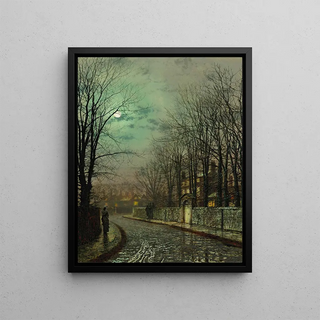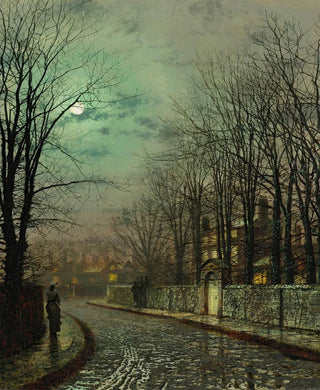Art print | The Meeting - John Atkinson Grimshaw


View from behind

Frame (optional)
In the fascinating world of art, some works manage to capture the very essence of urban life and human emotions. "The Meeting," painted by John Atkinson Grimshaw, is one of those creations that naturally evoke admiration and reflection. This canvas, imbued with mystery and romance, transports us to a nocturnal atmosphere where the glow of streetlights blends with the shadows of cobbled streets. The artist succeeds in evoking an ambiance that is both melancholic and hopeful, revealing the subtleties of human interactions within an urban setting. By contemplating this piece, the viewer is invited to ponder the hidden stories behind the depicted characters, while being enchanted by the beauty of the night landscape.
Style and uniqueness of the work
Grimshaw's style is distinguished by his masterful use of light and color. "The Meeting" perfectly illustrates this mastery, where warm and cool tones intertwine to create a striking visual harmony. The reflections of streetlights on the wet cobblestones, as well as the silhouettes of the characters, are rendered with precision that highlights the artist's talent. The composition of the piece, with its play of shadows and light, creates a depth that draws the eye and invites exploration. Every detail, whether it be the leaves of trees or the clothing of the protagonists, seems carefully thought out to enrich the visual storytelling. This attention to detail, coupled with a poetic atmosphere, gives "The Meeting" a singularity that continues to fascinate art enthusiasts.
The artist and his influence
John Atkinson Grimshaw, born in 1836, is often associated with the Pre-Raphaelite movement, although he developed a style that is uniquely his own. His work mainly focuses on nocturnal scenes, where he captures the magic of artificial lights and the charm of urban landscapes. Grimshaw drew inspiration from everyday life, as well as from literature and poetry, which is reflected in the narrative dimension of his paintings. His influence extends beyond his

Matte finish

View from behind

Frame (optional)
In the fascinating world of art, some works manage to capture the very essence of urban life and human emotions. "The Meeting," painted by John Atkinson Grimshaw, is one of those creations that naturally evoke admiration and reflection. This canvas, imbued with mystery and romance, transports us to a nocturnal atmosphere where the glow of streetlights blends with the shadows of cobbled streets. The artist succeeds in evoking an ambiance that is both melancholic and hopeful, revealing the subtleties of human interactions within an urban setting. By contemplating this piece, the viewer is invited to ponder the hidden stories behind the depicted characters, while being enchanted by the beauty of the night landscape.
Style and uniqueness of the work
Grimshaw's style is distinguished by his masterful use of light and color. "The Meeting" perfectly illustrates this mastery, where warm and cool tones intertwine to create a striking visual harmony. The reflections of streetlights on the wet cobblestones, as well as the silhouettes of the characters, are rendered with precision that highlights the artist's talent. The composition of the piece, with its play of shadows and light, creates a depth that draws the eye and invites exploration. Every detail, whether it be the leaves of trees or the clothing of the protagonists, seems carefully thought out to enrich the visual storytelling. This attention to detail, coupled with a poetic atmosphere, gives "The Meeting" a singularity that continues to fascinate art enthusiasts.
The artist and his influence
John Atkinson Grimshaw, born in 1836, is often associated with the Pre-Raphaelite movement, although he developed a style that is uniquely his own. His work mainly focuses on nocturnal scenes, where he captures the magic of artificial lights and the charm of urban landscapes. Grimshaw drew inspiration from everyday life, as well as from literature and poetry, which is reflected in the narrative dimension of his paintings. His influence extends beyond his






